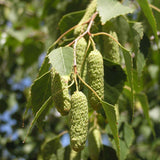Bare Root Silver Birch Bundle 60/90cm x 50
(Betula Pendula)
Silver Birch is a striking, deciduous plant which forms stunning, elegant, drooping branches and distinct silver-like bark- always fantastic in a native hedging scheme!
Silver Birch is a striking, deciduous plant which forms stunning, elegant, drooping branches and distinct silver-like bark- always fantastic in a native hedging scheme!







